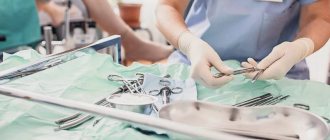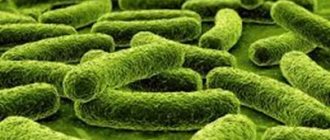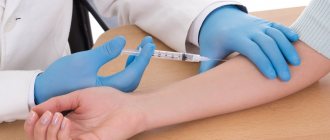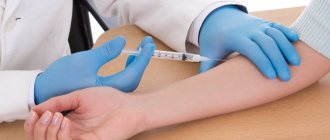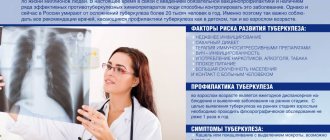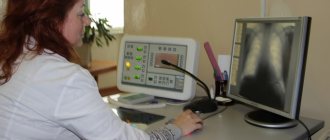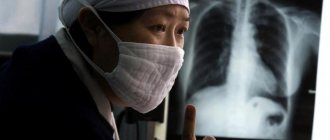Diaskintest® (tuberculosis allergen recombinant in standard dilution) is an innovative intradermal diagnostic test, which is a recombinant protein containing two interconnected antigens - ESAT6 and CFP10, characteristic of pathogenic strains of mycobacterium tuberculosis (Mycobacterium tuberculosis)1. These antigens are absent in the vaccine strain Mycobacterium bovis BCG and in most non-tuberculous mycobacteria, therefore Diaskintest® causes an immune reaction only to Mycobacterium tuberculosis and does not give a reaction associated with BCG vaccination. Thanks to these qualities, Diaskintest® has almost 100% sensitivity and specificity2, minimizing the likelihood of developing false-positive reactions, which are observed in 40–60% of cases when using the traditional intradermal tuberculin test (Mantoux test)3. The technique for performing the Diaskintest and recording the results is identical to the Mantoux test with tuberculin4.
In Russia, the use of Diaskintest was approved in 2009 by Order of the Ministry of Health of the Russian Federation 855 of October 29, 20094
Since 2021, the use of Diaskintest in screening for tuberculosis in children over 7 years of age and adolescents is regulated by Order of the Russian Ministry of Health No. 124n dated March 21, 20215.
Diaskintest is highly sensitive and highly informative: it allows you to exclude false-positive reactions that occur during the Mantoux test in vaccinated individuals (post-vaccination immunity). According to various estimates and in different regions of Russia, the sensitivity of Diaskintest is about 96%.
How does Diaskintest differ from the Mantoux reaction?
Due to the fact that the drug DIASKINTEST contains proteins that cause an immune response only to the presence of pathogenic (capable of causing disease) mycobacterium tuberculosis, the test has a higher sensitivity compared to the Mantoux river (the ability to detect infection in those who actually have it ) and, most importantly, higher specificity (the ability to give a negative reaction in those who do not have an infection).
Mantoux, Diaskintest test, Quantiferon test or T.SPOT? How do the methods for diagnosing tuberculosis differ and which one to choose?
Is it possible to be allergic to Diaskintest?
An allergic reaction is an individual manifestation of the activity of the immune system. It is impossible to predict how the immune system will behave when it is “acquainted” with a new drug. The test will not necessarily provoke an allergy, even in a child prone to food allergic reactions. But if this tendency exists, it would not be a bad idea to prepare for the injection.
According to Alexander Ushakov, children with allergies are recommended to start taking an antihistamine five days before the test and continue the course for two more days after it. If severe swelling occurs at the injection site, which obviously corresponds to an allergic reaction to Diaskintest, the course of the antihistamine should be extended, according to the doctor’s recommendation. And in the future, a child with allergies will be prescribed a Mantoux test instead of this test.
Parent Questions
Is it possible to do Diaskintest if allergies worsen?
Yes, but against the background of desensitizing therapy (5 days before and 2 days after the test).
Is it possible to eat sweets while on Diaskintest?
Can. But if you know that sweets can provoke an exacerbation of skin allergies, then it is better not to give them to your child.
Is it possible to do Diaskintest with a runny nose?
Yes, if it is not accompanied by an increase in temperature.
Is it possible to do Diaskintest immediately after an illness?
You should wait 2-3 days after the temperature has returned to normal. Residual runny nose and cough are not a contraindication and will not affect the results of Diaskintest.
Can Diaskintest provoke tuberculosis?
Preparations for Diaskintest are obtained from genetically modified strains of Escherichia coli, which in no case can cause the development of tuberculosis. Diaskintest is usually very well tolerated, only in rare cases there is a short-term and slight increase in temperature, mild headache and malaise.
Is it possible to wet Diaskintest and is it possible to go to the pool after Diaskintest?
Yes, you can wet Diaskintest and wash yourself. But it is still better to avoid exposure to chemical irritants (shampoos, reagents in the pool). Also try to prevent the child from scratching the sample.
What should a child not do after Diaskintest?
You should not rub or scratch the injection site, or apply any chemicals (iodine, brilliant green, hydrogen peroxide, creams) to it; for the same reason, you should not visit the pool. Everything else (walking, swimming, eating everything that does not cause an allergic reaction in your child) is possible.
What to do if a purple bruise remains after Diaskintest?
Don't worry ahead of time. Firstly, the bruise may completely disappear by the time of the test. Secondly, the size of the bruise also matters. During the test, the doctor will measure your reaction to the test and give you precise instructions on what to do next.
Can there be a fever after Diaskintest?
Yes, elevated temperature after Diaskintest in children is quite possible. Usually the discomfort does not last long and goes away on its own without treatment. What to do if you have a high temperature after Diaskintest? Most likely, it is associated not with the tests being carried out, but with ARVI or another disease that coincided with the time of Diaskintest.
Is it possible to get vaccinated after Diaskintest?
The interval between vaccinations (including BCG) and Diaskintest should be at least 1 month. If the Diaskintest result is negative, you can start vaccination immediately after the test.
Is it possible to do Diaskintest after Mantoux?
Yes, you can do Diaskintest after the Mantoux test.
Is it possible to refuse Diaskintest?
Yes, you can refuse Diaskintest and replace it with other tests for tuberculosis, such as the Mantoux test, quantiferon test or T-spot, as well as fluorography for children 15-17 years old. We do not advise you to refuse tuberculosis tests as such: the epidemic situation in Russia remains tense.
You can always ask all your questions and consult about Diaskintest in your particular case with our pediatricians by phone: +7 812 331 00 00.
What is Diaskintest at school
Russia is one of the few countries in the world where vaccination against tuberculosis is mandatory. Each child is given the BCG vaccine at birth, and then, several years later, according to the National Preventive Vaccination Calendar, revaccination is carried out. Thanks to this systematic approach, our country maintains a low incidence of tuberculosis.
However, such cases still occur. Tuberculosis is an insidious disease and can affect people with reduced immunity. Special tests can determine the presence of a pathogen in the body. Previously, only the Mantoux test was used for this purpose. There were no alternatives to it, so doctors had to put up with its “shortcomings.”
Firstly, a positive reaction, which often occurs not at all as a response to infection, but after BCG vaccination. Secondly, a positive reaction can persist for many years in people who have had the disease, but no longer pose a danger to others.
When testing a child and receiving a positive result, the doctor always has a difficult decision to make. Additional diagnostics, specific treatment - all this may not be necessary, but is prescribed by a specialist to dispel doubts.
With the advent of Diaskintest, these shortcomings are a thing of the past. The drug does not react with strains that are introduced into the body during vaccination. It is a combination of antigens of two types of tuberculosis bacteria that most often cause the disease. If these bacteria are not in the body, then there will be no reaction. Therefore, the question - which is better, Mantoux or Diaskintest - was decided by the Ministry of Health back in 2009.
“According to general recommendations, children aged one to seven years are given a Mantoux test,” said pediatrician Alexander Ushakov. - After eight years and up to 17 years - only Diaskintest. This drug is also used in adults. In addition, it is prescribed for the diagnosis of tuberculosis if the Mantoux test gives a positive result. Then Mantoux and Diaskintest are carried out almost simultaneously, a few days later.”
Mantoux – vaccination or test?
Vaccination against tuberculosis - BCG. The vaccine is named after the names of the scientists who created it in capital letters: Bacillus Calmette-Guérin (BCG). The vaccine contains live but inactivated bovine mycobacteria. The first vaccination is given to newborns in the maternity hospital, usually on the 4th day of the child’s life.
Many people do not understand why vaccination is done so early, where can a baby encounter this infection? In fact, the situation with tuberculosis in our country is unfavorable, and not all tuberculosis patients know about their disease. They don’t even suspect that they are contagious and lead a normal life. TB doctors know that the earlier a child is infected, the greater the likelihood of the infection turning into a disease. And the sooner he is vaccinated, the faster the baby will develop immunity and he will be protected. There is even a grotesque poem on this topic, the author of which, unfortunately, is unknown:
“When they come to ask for permission for a child to have BCG done,
And this will be after the birth, but before discharge, Don’t allow it - there are no tuberculosis patients in your family, So that you don’t get infected from others - do your shopping on the Internet, Walk away from all passers-by, visit your girlfriends don't drive, Let your husband quit his job. Warn your relatives that you don’t want to see them anymore for ten years. Kindergarten and school are flying by and warm greetings to the university. Let the child grow up at home, under his mother’s skirt - All wild, unlearned, without life goals or ideas. Old age will creep up unnoticed. He won’t give you water - he’ll go out into the street to get it and get lost there. Alas."
So, in response to vaccination, the body produces protective antibodies - immunity is formed. Immune memory weakens over time, so revaccination is required (repeated administration of the vaccine at seven and 14 years). BCG does not provide 100% protection against tuberculosis, but in case of infection it significantly reduces the risk of complications and death, promotes a milder course of the disease and a faster recovery.
Mantoux allows you to:
- determine the body’s sensitivity to mycobacteria;
- identify the hidden form of the disease;
- assess the risk of developing the disease in the future.
In other words, using the test, you can not only detect tuberculosis in a timely manner, but also predict the immune response to infection.
What's included
The drug contains a complex mixture of mycobacterial proteins - tuberculin. It is pre-cleaned and treated with special solutions. It does not pose a danger to human health and is not a cause of tuberculosis.
FROM THE HISTORY. Tuberculin was discovered by the German microbiologist R. Koch in 1890 for the treatment of tuberculosis. The crude composition led to numerous and severe toxic effects, recovery did not occur, so it was perceived critically by society. But as tuberculin was further used in animals, the diagnostic properties of the drug were discovered. In 1907, a scientist from Austria, K. Pirke, proposed using tuberculin diagnostics for people using a skin test. And in 1908, C. Mantoux (France) developed a method of intradermal administration, which is used in diagnostic practice to this day. The purified preparation was adopted by WHO as an international standard in 1952.
Contraindications
Only a doctor can decide whether Diaskintest is suitable for testing for tuberculosis.
The Diaskintest test is not recommended and is not performed on children under 7 years of age inclusive.
"Diaskintest" is contraindicated for persons with allergic and autoimmune diseases! Also, the use of Diaskintest is contraindicated in the following cases:
- Acute diseases or exacerbation of chronic diseases (except for cases of suspected tuberculosis).
- Skin diseases.
- Epilepsy.
- In children's groups where there is a quarantine for childhood infections, the test is carried out only after the quarantine is lifted.
Possible side effects
For most, the test process is asymptomatic.
Headaches, general weakness, sleep disturbances, and increased body temperature may occur. Individuals with altered reactivity experience allergic reactions. Considering the possibility of developing immediate allergic reactions (anaphylactic shock, Quincke's edema, urticaria) in particularly sensitive individuals, vaccinated persons must be provided with medical supervision for 30 minutes.
Come get vaccinated at ONNI.
A full range of vaccines for children and adults, family vaccinations - at a special price! Call a doctor at home Make an appointment with a doctor or call +7 (812) 331-17-74
The principle of action of the drug "Diaskintest"
The action of the drug "Diaskintest" is based on the detection of a cellular immune response to antigens specific to Mycobacterium tuberculosis. When the drug is administered intradermally in persons with tuberculosis infection, a specific skin reaction occurs, which is a manifestation of delayed-type hypersensitivity.
To identify (diagnosis) tuberculosis infection, a test with Diaskintest is carried out:
- children sent to an anti-tuberculosis institution for additional examination for the presence of a tuberculosis process;
- children belonging to high-risk groups for tuberculosis, taking into account epidemiological, medical and social risk factors;
- children referred to a phthisiatrician based on the results of mass tuberculin diagnostics (Mantoux).
Important! A test with the drug "Diaskintest" cannot be used instead of a tuberculin test (Mantoux) to select individuals for primary vaccination and revaccination with BCG
Evaluation of test results with Diaskintest
The result of the test is assessed by a doctor or trained nurse 72 hours after it was performed by measuring the transverse (relative to the axis of the forearm) size of the hyperemia (redness) and infiltrate (papules) in millimeters with a transparent ruler.
Hyperemia is taken into account only in the absence of infiltration.
The response to the test is considered:
- negative - in the complete absence of infiltration and hyperemia or in the presence of a “puncture reaction” of up to 2 mm;
- doubtful - in the presence of hyperemia without infiltration;
- positive - in the presence of infiltrate (papules) of any size.
Positive reactions conditionally vary in severity:
- mild reaction - in the presence of infiltrate up to 5 mm in size;
- moderate reaction - with an infiltrate size of 5-9 mm;
- pronounced reaction - with an infiltrate size of 10-14 mm;
- hyperergic reaction - with an infiltrate size of 15 mm or more, with vesicular-necrotic changes and (or) lymphangitis, lymphadenitis, regardless of the size of the infiltrate.
Persons with questionable and positive reactions are examined for tuberculosis.
There is usually no reaction to Diaskintest:
- in persons not infected with Mycobacterium tuberculosis;
- in persons previously infected with Mycobacterium tuberculosis with inactive tuberculosis infection;
- in patients with tuberculosis during the period of completion of the involution of tuberculous changes in the absence of clinical, X-ray tomographic, instrumental and laboratory signs of process activity;
- in persons cured of tuberculosis;
- in persons with extrapulmonary localization of tuberculosis.
At the same time, a test with the drug "Diaskintest" may be negative in patients with tuberculosis with severe immunopathological disorders caused by a severe course of the tuberculosis process, in persons in the early stages of infection with Mycobacterium tuberculosis, in the early stages of the tuberculosis process, in persons with concomitant diseases accompanied by an immunodeficiency state.
Indications for use of "Diaskintest"
"Diaskintest" is used to conduct an intradermal test in children over 8 years of age, instead of the Mantoux test, for the purpose of diagnosing tuberculosis of exclusively pulmonary localization, assessing the activity of the process and identifying patients at high risk of developing an active tuberculosis process. "Diaskintest" is intended for performing an intradermal test for the following purposes:
- children from high-risk groups for tuberculosis who are not subject to dispensary registration by a phthisiatrician
- to identify patients at high risk of developing active tuberculosis (latent tuberculosis infection)
- for differential diagnosis of post-vaccination (BCG) and infectious allergies (delayed-type hypersensitivity)
- to evaluate the effectiveness of anti-tuberculosis treatment in combination with other methods
- in patients suffering from diabetes mellitus, peptic ulcer disease
- in patients with chronic nonspecific purulent-inflammatory diseases of the bronchopulmonary system and kidneys
- in HIV-infected patients
- in patients receiving long-term immunosuppressive therapy (cytostatics, corticosteroids, genetically engineered biological drugs (GEBP), etc.)
How to help your child feel comfortable during the test
The test goes better when the child is calm and not afraid. Diaskintest is performed on children over 7 years old; however, even at that age, children may still be afraid of vaccinations or injections. To calm your child, try the following:
- Talk softly to your child.
- Be calm, confident, smile.
- Explain to your child why the test is needed, what its benefits are, and why it is safe.
- After vaccination, be sure to support your child with words, tell him how great he is and how proud you are of him.
Photos of results
You can independently determine the test result without waiting for an examination by a nurse using a photo with the results of the test.
Diaskintest photo performed on a child has a positive result. The size of the infiltrate is more than 5 mm.
With a comparative result, the infiltrate size is 2-4 mm.
The photo provided indicates a negative result. With it, there may be a trace of the injection, the infiltrate is completely absent.
Why do you need to get the DST vaccine?
The causative agent of the disease is Mycobacterium tuberculosis. Develops against a background of decreased immunity, malnutrition, frequent hypothermia, malnutrition, HIV infection, drug addiction, and nervous hypothermia. Transmitted in several ways:
- Airborne: through communication, sneezing, contact with a patient;
- Household: when using dishes, things, kissing, etc.;
- Through contact with the carrier;
- Food: eating affected food;
- Intrauterine: from mother to child.
In the acute form of tuberculosis, a prolonged and wet cough with sputum production is observed; hyperthermia. The patient sharply loses weight, complains of fatigue, and a general deterioration in health. Performance is lost.
The cough is wet and pronounced. Occurs in the form of frequent attacks, especially in the morning. Often the disease at the initial stage is mistakenly confused with “smoker’s cough”, symptoms of chronic bronchitis.
According to statistics in the CIS countries, approximately 90% of people are carriers of Koch's bacillus. In this case, 5% get sick. The development of tuberculosis depends on the level of immunity. Therefore, the main method of preventing the disease is maintaining a healthy lifestyle. Children are required to be vaccinated; regular samples and tests are carried out, with the help of which it is possible to establish in the early stages. Diaskintest is a solution that helps identify the disease in the early stages.
Expert opinion
Author:
Alexander Vyacheslavovich Averyanov
Pulmonologist, Doctor of Medical Sciences, Professor, doctor of the highest qualification category
According to statistics, 90% of the population are carriers of the Koch bacillus, the causative agent of tuberculosis. However, the incidence is recorded in only 5%. The disease develops against the background of immunodeficiency, so it is important to lead a healthy lifestyle and engage in prevention.
Diaskintest allows you to diagnose tuberculosis. The method differs from the classical Mantoux in its accuracy. The effectiveness of Diaskintest is 90%. For comparison, Mantoux's accuracy ranges from 50 to 70%. The Yusupov Hospital uses Diaskintest to diagnose tuberculosis. The method is also effective for preventive purposes. Results are assessed after 72 hours. Diaskintest is well tolerated and rarely causes allergic reactions. Even if individual intolerance to a component of the test occurs, undesirable reactions disappear after 2–3 days.
Diaskintest has proven itself on the positive side with most domestic doctors. Diagnostics is being actively introduced into medical institutions. High efficiency allows you to prescribe correct treatment. This is important, since tuberculosis is characterized by a progressive course and high mortality without adequate therapy.
